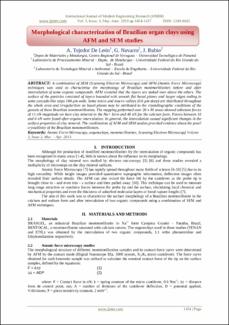Mostrar el registro sencillo del ítem
Morphological Characterization of Brazilian Organ Clays Using AFM and SEM Studies
| dc.contributor.author | Tejedor De León, A. | |
| dc.contributor.author | Navarro, G. | |
| dc.contributor.author | Rubio, J. | |
| dc.date.accessioned | 2017-08-23T16:56:39Z | |
| dc.date.accessioned | 2017-08-23T16:56:39Z | |
| dc.date.available | 2017-08-23T16:56:39Z | |
| dc.date.available | 2017-08-23T16:56:39Z | |
| dc.date.issued | 2013-05 | |
| dc.date.issued | 2013-05 | |
| dc.identifier.uri | http://ridda2.utp.ac.pa/handle/123456789/2863 | |
| dc.identifier.uri | http://ridda2.utp.ac.pa/handle/123456789/2863 | |
| dc.description | A combination of SEM (Scanning Electron Microscopy) and AFM (Atomic Force Microscopy) techniques was used to characterise the morphology of Brazilian montmorillonites before and after intercalation of some organic compounds. AFM revealed that the layers are staked over above the others. The surface of the particles consisted of layers bounded with smooth flat basal planes and larger edges ending in some cascade-like steps 184 µm wide. Some micro and macro valleys (0.6 µm deep) are distributed throughout the whole area and irregularities on basal planes may be attributed to the crystallographic conditions of the genesis of these Brazilian montmorillonites. The mapping performed over 20 x 40 areas showed adhesion forces of 11 nN magnitude on bare clay mineral in the Na+ form and 40 nN for the calcium form. Forces between 10 and 6 nN were found after organic intercalation. In general, the intercalation caused significant changes in the surface properties of clay mineral. The combination of AFM and SEM studies provided evidence about the poorl crystallinity of the Brazilian montmorillonites. | en_US |
| dc.description.abstract | A combination of SEM (Scanning Electron Microscopy) and AFM (Atomic Force Microscopy) techniques was used to characterise the morphology of Brazilian montmorillonites before and after intercalation of some organic compounds. AFM revealed that the layers are staked over above the others. The surface of the particles consisted of layers bounded with smooth flat basal planes and larger edges ending in some cascade-like steps 184 µm wide. Some micro and macro valleys (0.6 µm deep) are distributed throughout the whole area and irregularities on basal planes may be attributed to the crystallographic conditions of the genesis of these Brazilian montmorillonites. The mapping performed over 20 x 40 areas showed adhesion forces of 11 nN magnitude on bare clay mineral in the Na+ form and 40 nN for the calcium form. Forces between 10 and 6 nN were found after organic intercalation. In general, the intercalation caused significant changes in the surface properties of clay mineral. The combination of AFM and SEM studies provided evidence about the poorl crystallinity of the Brazilian montmorillonites. | en_US |
| dc.language | eng | |
| dc.language.iso | eng | en_US |
| dc.rights | https://creativecommons.org/licenses/by-nc-sa/4.0/ | |
| dc.rights | info:eu-repo/semantics/openAccess | |
| dc.subject | atomic force microscopy | en_US |
| dc.subject | organoclays | en_US |
| dc.subject | montmorillonites | en_US |
| dc.subject | scanning electron microscopý | en_US |
| dc.subject | atomic force microscopy | |
| dc.subject | organoclays | |
| dc.subject | montmorillonites | |
| dc.subject | scanning electron microscopý | |
| dc.title | Morphological Characterization of Brazilian Organ Clays Using AFM and SEM Studies | en_US |
| dc.type | info:eu-repo/semantics/article | |
| dc.type | info:eu-repo/semantics/publishedVersion |
